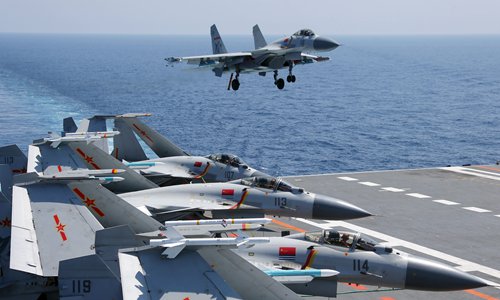Chinese aircraft carriers get power boost by fighters’ nighttime buddy refueling capability
By Liu Xuanzun Source: Global Times Published: 2020/7/28 17:57:09

A ship-borne J-15 fighter jet prepares to land at the flight deck of the aircraft carrier Liaoning (Hull 16). A Chinese Navy flotilla including aircraft carrier Liaoning has conducted a series of exercises in the South China Sea since the grand naval parade last Thursday. (eng.chinamil.com.cn/Photo by Zhang Lei)
China's aircraft carrier-based J-15 fighter jets have now become capable of conducting nighttime buddy refueling, one of the most challenging tactical moves by carrier-borne fighter jets, the PLA Navy revealed after recent successful exercises.
Nighttime buddy refueling operations can significantly boost aircraft carriers' round-the-clock combat capabilities, as such operations extend their combat range and enable more firepower, military experts said Tuesday.
For the first time, J-15 fighter jets affiliated with the People's Liberation Army (PLA) Navy recently completed a set of aerial buddy refueling exercises at night, the PLA Navy announced on Monday.
This marked a new breakthrough in the all-weather, long-range combat capability of China's carrier-based aircraft forces, it said.
The term "buddy refueling" means both the feeding aircraft and receiving aircraft are of the same type of warplane, and in this case, it means a J-15 equipped with a refueling pod refuels other J-15s, reports said.
The PLA Navy has previously grasped the techniques of buddy refueling in the day, the China Central Television (CCTV) reported on Tuesday.
Zhang Ye, a PLA Navy aircraft carrier aviation officer, said on CCTV that crew members have accomplished nighttime buddy refueling exercises with multiple batches of aircraft when there was no previous experience to refer to.
Nighttime buddy refueling is more challenging than daytime due to lower visibility and possibly worse meteorological conditions, Zhang Junshe, a senior research fellow at the PLA Naval Military Studies Research Institute, told the Global Times on Tuesday.
This will allow China's aircraft carriers to cover wider mission areas at night as their fighter jets can receive extra fuel mid-air and extend their range, according to Zhang.
Buddy refueling can boost an aircraft carrier's firepower by allowing fighter jets to carry more weapons and less fuel when taking off, and refuel afterwards in the air, experts said, noting that China's two aircraft carriers, the Liaoning and the Shandong, use jump-rack decks rather than catapults, which has limited the maximum payload of aircraft at takeoff.
Usually aerial refueling features an aerial tanker as the feeding aircraft, but traditional tankers are too large for an aircraft carrier, so it is a widely-used practice to reconfigure a small number of fighter jets to carry more fuel and fewer weapons and act as smaller tankers, military observers said.
Posted in: MILITARY